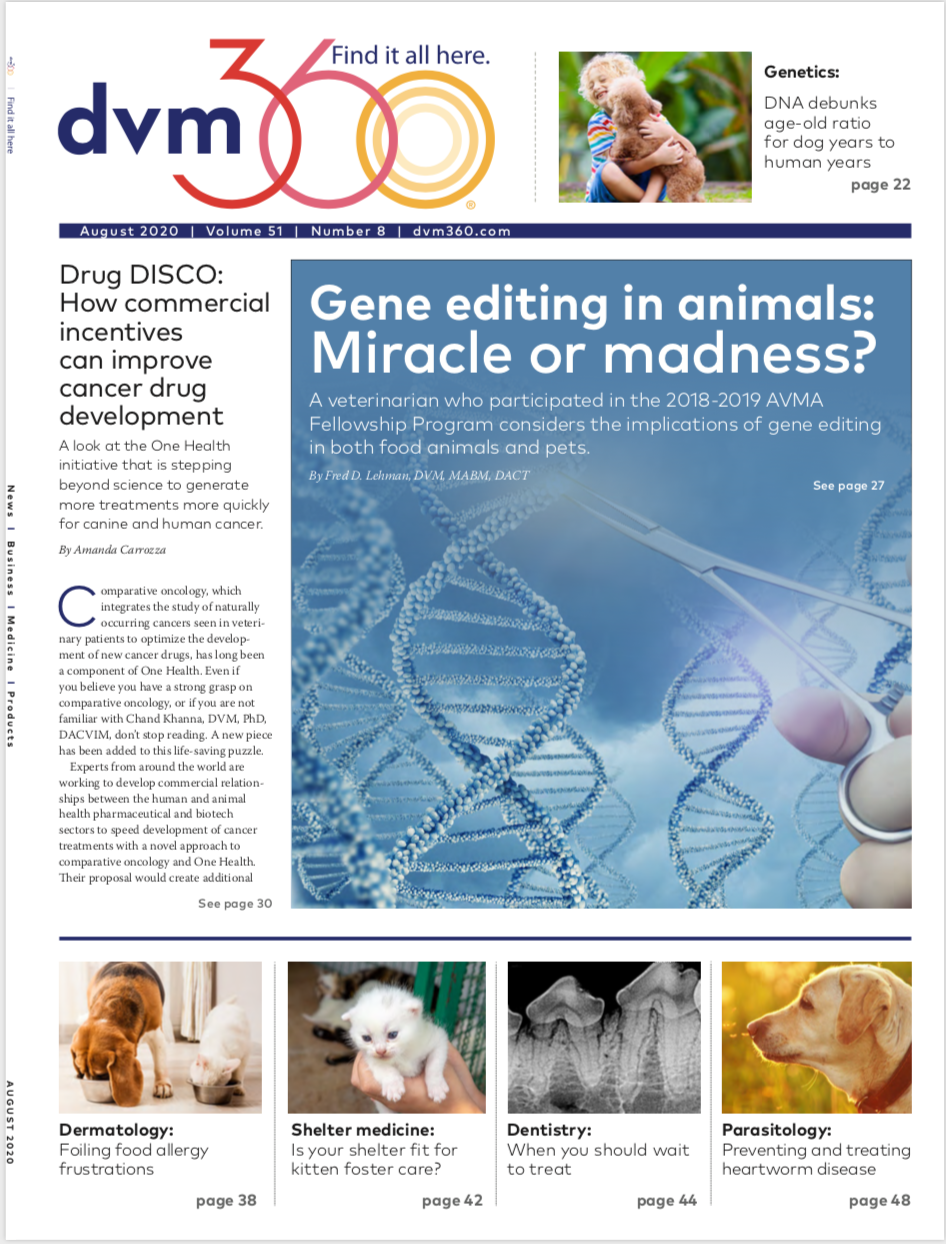Foiling food allergy frustrations in dogs and cats
Hungry for more information on food allergies, and the associated dermatologic conditions in dogs? Use these tips to help your veterinary team discern dietary sensitivities in your patients.
chalabala/stock.adobe.com

As a practicing dermatologist at a high-volume specialty clinic in Wheat Ridge, Colorado, Darin Dell, DVM, DACVD, is no stranger to pets with dietary sensitivities. At Fetch dvm360 conference in Baltimore, Dr. Dell provided an update on best practices for managing food allergy cases.
“Understanding the key differences between food allergies and other dietary conditions can help veterinarians diagnose and manage allergy cases with confidence,” Dr. Dell explained. He also made sense of many “truths and lies” surrounding the use of grain-free, raw and home-cooked diets.
Food allergy or something else?
Just like any other allergy, food allergy is immunologically mediated and requires sensitization after repeated exposure to a particular antigen. By contrast, food intolerance is a physiologic reaction lacking any immunologic component; therefore, intolerance can occur from a single exposure to a food. Sometimes dermatologists use the term "cutaneous adverse food reaction," which is an all-encompassing term for all other food-related reactions.
Although nearly any dietary component can cause cutaneous adverse food reaction, true food allergies typically occur to proteins ranging from 10 and 70 kDa in size. Beef, poultry and dairy are three of the most common food allergens in dogs and cats. Closely related allergens, such as duck and poultry, or venison and beef, can cross-react because they share similar molecular structures.
Unlike environmental allergies, food allergies cause nonseasonal signs. Recent statistics estimate that 25% of the cases of nonseasonal pruritus result from food allergies. Remember that clinical signs often affect the “ears and rears” and may include recurrent otitis externa as well as perianal licking and scooting. Affected dogs may also paw at the muzzle and have pruritus of the distal limbs, whereas cats may develop facial pruritus, miliary dermatitis and eosinophilic granuloma complex. One-quarter of pets with food allergy also display gastrointestinal signs, including diarrhea, flatulence and vomiting.
As a general rule, food allergy is most common when animals develop symptoms very young (less than 18 months of age) or later in life (greater than 9 years of age). This can be confusing because some atopic (environmental allergy) patients develop mild symptoms mid-life (age 2-5) but don't present to their Veterinarian for severe symptoms until age eight or nine. Collecting a thorough history is very important! At this time, food allergy has no known genetic component.
Enduring the elimination diet
Dr. Dell admitted that diagnosing food allergy can be difficult, particularly when clients “feed eight different types of treats, alternate foods or buy whatever is at the pet store.” Diagnosis is further complicated by the lack of straightforward tests. He described serum allergy tests as generally “inaccurate and unrepeatable,” because cooking and preparing foods can significantly alter their antigenic properties. While at-home hair and saliva tests are currently trending, these are simply “not based on scientific principles,” according to Dr. Dell and cannot detect allergens accurately.1 Furthermore, most at-home tests measure IgA, an expected component of saliva even in nonallergic pets.
Dietary elimination and rechallenge remains the most reliable method of diagnosis. Dr. Dell recommended an 8-week elimination period to allow for complete resolution of intestinal inflammation and any secondary infections. Some clients choose not to pursue a rechallenge, which is acceptable “if the client is happy and the dog looks and feels good.” Although pets typically react to a rechallenge within a few hours, Dr. Dell advised rechallenging with the suspect protein for 14 days or until a reaction is observed, whichever occurs first.
He did not recommend feeding over-the-counter diets during dietary trials, as these have a significantly higher risk of ingredient contamination compared with prescription diets. One recent study showed that many commercial pet diets contained proteins not included on the label.2 To further minimize the risk of cross-contamination during a dietary trial, Dr. Dell recommended washing stainless-steel or ceramic food bowls in the dishwasher on the highest temperature setting before use, and storing food in its original packaging. Flavored prophylactic medications should be replaced with injectable or topical options for the duration of the trial, and vegan marshmallows should replace peanut butter and pill pockets for hiding medications. In general, he stated, compliance is higher when clients are provided with safe options, such as oat-filled Kong toys, rather than complete restriction of treats.
Choosing a hypoallergenic diet
Because related proteins often share similar molecular structures, pets may experience allergic reactions even without previous exposure to a particular meat. For example, a salmon-allergic cat may react to multiple types of fish. Similarly, allergic pets may react to different diets if they contain the same hydrolyzed proteins. Most hydrolyzed proteins in commercial diets actually exceed the 10-kDa size limit and are therefore not truly hypoallergenic. An exception is Royal Canin Ultamino, which undergoes feed analysis to ensure protein size.
Dr. Dell also discussed responsible options for clients who insist on feeding raw, homemade or grain-free diets. He recommended keeping an arsenal of reputable literature on hand, including the World Small Animal Veterinary Association's Global Nutrition Guidelines and the American College of Veterinary Nutrition's nutrition resources. These publications explain the lack of published support for many alternative diet choices, as well as their associated health risks.
While raw diets offer no known nutritional benefit over other diets, they do increase the risk of foodborne illness to both pets and clients. Likewise, studies have demonstrated that not only are grain-free diets often less nutritious than other diets, they have been associated with the development of dilated cardiomyopathy (DCM) in pure and mixed-breed dogs, particularly golden retrievers. In one study, 90% of dogs presenting with DCM were fed diets whose top ingredients included peas, lentils, legumes or potatoes.3 Unlike with feline DCM, a clear correlation between canine diet-associated DCM and taurine deficiency is not yet proven; however, taurine supplementation is currently recommended for suspect cases until the pathogenesis of this condition is more completely understood, and feeding of boutique, exotic protein or grain-free (BEG) diets is generally discouraged.
Interestingly, there are no reports of diet-associated DCM from grain-free prescription diets, perhaps because such diets are required to meet strict quality standards. Dr. Dell recommended choosing these diets for pets with confirmed grain sensitivities, although grains are rarely a source of food allergy in dogs and cats.
Finally, if a client insists on feeding a home-cooked diet, Dr. Dell recommended enlisting the help of a veterinary nutritionist. Certain companies can also work with practitioners to customize diets to a patient's individual health needs, thus ensuring optimal nutrition.
References
1. Bernstein JA, Tater K, Bicalho RC, et al. Hair and saliva analysis fails to accurately identify atopic dogs or differentiate real and fake samples. Vet Dermatol 2019;30(2):105-e28.
2. Fossati LA, Larsen JA, Villaverde C, et al. Determination of mammalian DNA in commercial canine diets with uncommon and limited ingredients. Vet Med Sci 2019;5(1):30-38.
3. Freeman LM, Stern JA, Fries R, et al. Diet-associated dilated cardiomyopathy in dogs: what do we know? JAVMA 2018;253(11):1390-1394.
Dr. Stilwell received her DVM from Auburn University, followed by a MS in fisheries and aquatic sciences and a PhD in veterinary medical sciences from the University of Florida. She provides freelance medical writing and aquatic veterinary consulting services through her business, Seastar Communications and Consulting.
